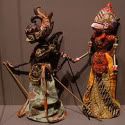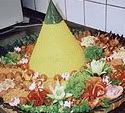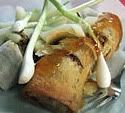
Lumpia
 Lumpia are pastries of the Philippines and Indonesia of Chinese origin and are similar to spring rolls. The term lumpia derives from lunpia (traditional Chinese: 潤餅; pinyin: rùnbǐng; POJ: jūn-piáⁿ, lūn-piáⁿ) in the Hokkien language. The recipe, both fried and fresh versions, was brought by the Chinese immigrants from the Fujian province of China to Southeast Asia and became popular where they settled in the Philippines and Indonesia. In the Netherlands, it is spelled loempia which is the old Indonesian spelling for lumpia and has also become the generic name for "spring roll" in Dutch. A variant is the Vietnamese lumpia, wrapped in a thinner piece of pastry, in a size close to a spring roll though the wrapping closes the ends off completely, which is typical for lumpia.
Lumpia are pastries of the Philippines and Indonesia of Chinese origin and are similar to spring rolls. The term lumpia derives from lunpia (traditional Chinese: 潤餅; pinyin: rùnbǐng; POJ: jūn-piáⁿ, lūn-piáⁿ) in the Hokkien language. The recipe, both fried and fresh versions, was brought by the Chinese immigrants from the Fujian province of China to Southeast Asia and became popular where they settled in the Philippines and Indonesia. In the Netherlands, it is spelled loempia which is the old Indonesian spelling for lumpia and has also become the generic name for "spring roll" in Dutch. A variant is the Vietnamese lumpia, wrapped in a thinner piece of pastry, in a size close to a spring roll though the wrapping closes the ends off completely, which is typical for lumpia.Lumpia Basah
It literally means "wet spring roll" which means spring roll without frying. It is similar to the Vietnamese spring roll with bean sprouts, carrots, shrimp and/or chicken, and served with sweet tauco (another Hokkien word for salted soybeans) sauce.
Lumpia Semarang
Named after the capital city of Central Java in Indonesia, Semarang. It was created by Chinese immigrants in the city of Semarang. It is filled with bamboo shoots, dried shrimp (ebi in Indonesian) chicken and/or prawn. It is served with lumpia sauce that is made from dried shrimp (optional), coconut sugar, red chillies, bird's eye chilies, water, ground white pepper, tapioca starch and water and can be served in either fried or unfried condition. (source)



















0 comments:
Post a Comment